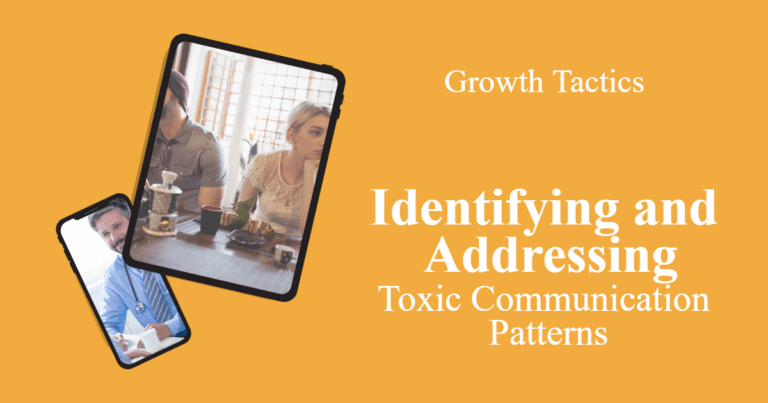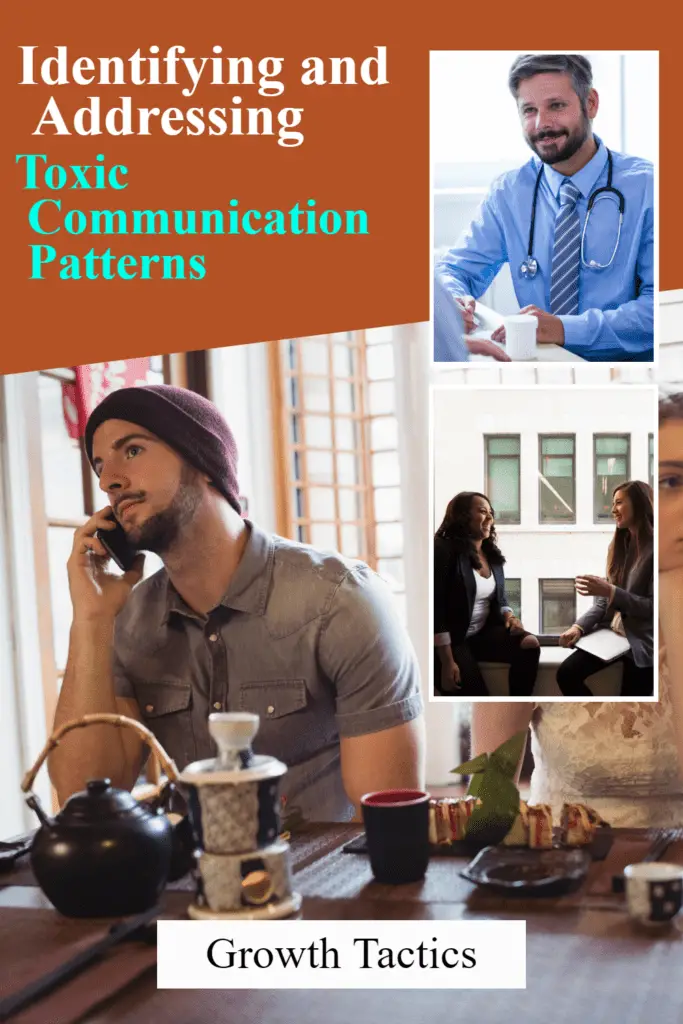Communication is a crucial aspect of any successful relationship, be it personal or professional. However, sometimes communication patterns can become toxic, which can lead to a breakdown in communication, relationship failure, and negative psychological consequences. In this post, we will explain what constitutes toxic communication patterns, and some common tendencies of toxic communication, and provide tools to address and overcome these toxic patterns.
Jump To Section
What is toxic communication?
Toxic communication refers to a pattern of communication between two or more individuals that is characterized primarily by negativity and conflict. This communication pattern is harmful to the individuals involved and can sometimes be cyclical, which means that it follows a pattern of painful fights or even breakups.
What are the tendencies of toxic communication?
Toxic communication tendencies are often associated with cycles of painful fights or even breakups. According to Psychology Today, there are four primary communication tendencies that are often seen in toxic communication patterns: criticism, contempt, defensiveness, and stonewalling.
Criticism
Criticism refers to attacking a person’s character or personality instead of the specific behavior you hope to change. It often involves making negative judgments, such as calling your partner “a loser,” or saying that “you’re just insane.” Criticism is a form of disrespect that can be damaging to your partner’s self-esteem and well-being.
Contempt
Contemptuous communication is marked by feelings of superiority and an extreme disregard for a person’s feelings and needs. This style of communication can be demonstrated through sarcasm, name-calling, eye-rolling, or even nonverbal cues like sneering or scowling.
Defensiveness
Defensiveness is a natural response to feeling attacked, but it is not always positive. People who are feeling defensive might refuse to see their role in a conflict, take responsibility, or make efforts to understand their partner’s point of view. This tendency can escalate a disagreement and lead to larger conflicts.
Stonewalling
Stonewalling is characterized by shutting down during an argument and becoming non-responsive. This might involve the silent treatment or simply walking away from an argument. Stonewalling makes it impossible to resolve issues, and it can lead to frustration and resentment.
How can you address toxic communication patterns?
Dealing with toxic communication is really hard—it’s normal to feel angry, sad, or resentful when a relationship is experiencing a communication breakdown. However, there are ways to address these communication patterns and improve the situation.
Take Responsibility
One of the first steps to addressing toxic communication patterns is to recognize your role in these patterns. It can be easy to blame your partner for the breakdown in communication, but it’s important to acknowledge your own contributions as well. Take responsibility for your actions and how they contribute to unhealthy communication. Reflect on your own behavior and mindset and be willing to make changes to improve the situation.
Seek to Understand
When communication breaks down, it’s common to feel misunderstood or unheard. Instead of reacting defensively, try to seek understanding. Take the time to actively listen to your partner’s perspective and attempt to see things from their point of view. This requires empathy and a genuine curiosity to understand their thoughts, emotions, and needs. Ask open-ended questions to encourage them to share more, and be patient in your quest for understanding.
Take a Break
If a conflict becomes heated or overwhelming, it can be helpful to take a break and step away from the situation. Communication in the heat of the moment is often unproductive and can further escalate the conflict. Set a time limit for the break, communicate this with your partner, and make a plan to reconvene and discuss the issue when emotions have cooled down. Use this break as an opportunity to calm yourself, reflect on the situation, and consider alternative perspectives.
Increase Positive Communication
Toxic communication patterns often focus on negative aspects of the relationship. To counteract this, deliberately increase positive communication between you and your partner. Express appreciation for their efforts, achievements, and qualities. Offer genuine compliments and words of affirmation regularly. Engage in activities together that you both enjoy and that foster a positive and relaxed atmosphere. By nurturing positivity in your communication, you create an environment that promotes healthier dialogue and connection.
Use Healthier Communication Tools
Instead of relying on toxic communication patterns, actively choose to use healthier communication tools. These tools include:
Active Listening
Active listening involves giving your full attention to your partner, using nonverbal cues to show understanding, and paraphrasing their point of view to ensure accurate comprehension. It shows that you value their perspective and are willing to truly hear and understand them.
Empathy
Empathy is the ability to understand and share the feelings of another person. It involves putting yourself in your partner’s shoes and trying to genuinely understand their emotions and experiences. By practicing empathy, you create a safe and supportive space for open and honest communication.
“I” Statements
“I” statements are a useful communication tool that shift the focus from blame to expressing your own emotions and needs. Instead of saying things like “You always…” or “You never…”, use statements like “I feel…” or “I need…”. This helps your partner understand your perspective without feeling attacked or defensive.
Respecting Boundaries
People have different boundaries when it comes to communication. It’s important to understand and respect your partner’s boundaries. Respect includes giving them space when they need it, avoiding personal attacks, and refraining from bringing up past conflicts or sensitive topics that can escalate the situation.
Managing Conflict
Conflicts are a natural part of any relationship, but it’s important to approach them in a healthy and constructive way. This involves staying calm, finding compromises, and focusing on solutions rather than getting caught up in the heat of the argument. It may be helpful to attend couples counseling or seek guidance from a trained professional to learn effective conflict resolution strategies.
Set Clear Communication Goals and Boundaries
To improve communication, it’s essential to establish clear goals and boundaries. Discuss with your partner what you hope to achieve through better communication and set specific objectives. For example, you might aim to enhance understanding, resolve conflicts more effectively, or simply create a more positive and open atmosphere. Additionally, establish boundaries for healthy communication, such as avoiding insults or name-calling, giving each other space when needed, and respecting each other’s need for alone time.
Practice Mindful Communication
Mindfulness can greatly enhance communication by allowing you to be fully present in your interactions. When engaging in a conversation with your partner, commit to being fully attentive and engaged. Put away distractions, maintain eye contact, and actively listen to their words, tone, and nonverbal cues. Being mindful also involves remaining aware of your own thoughts, feelings, and reactions while communicating, allowing you to respond thoughtfully rather than reactively.
Seek Professional Help
If toxic communication patterns persist despite your efforts, it may be beneficial to seek professional help. Couples therapy or counseling can provide a safe and neutral space for both partners to express their concerns, learn effective communication strategies, and work through underlying issues. A trained professional can guide and support you in navigating difficult conversations, resolving conflicts, and building healthier communication patterns.
Foster Emotional Intelligence
Emotional intelligence is the ability to understand and manage your own emotions as well as recognize and empathize with the emotions of others. Developing emotional intelligence can greatly enhance communication dynamics. Work on increasing your self-awareness, recognizing your own emotions, and constructively communicating your needs and feelings. Additionally, practice empathy by trying to understand your partner’s emotions and responding with care and understanding.
Cultivate Healthy Communication Habits
Communication is not solely about conflict resolution; it encompasses everyday interactions as well. Cultivate healthy communication habits by incorporating positive practices into your daily routines. This may include carving out dedicated time to talk and connect with your partner, expressing appreciation and gratitude, actively showing interest in their experiences, and engaging in active listening consistently.
Regularly Evaluate and Adjust
Improving communication is an ongoing process. Regularly evaluate the effectiveness of your communication efforts and reflect on your progress. Check-in with your partner to gauge their perception and satisfaction with the changes you’ve made. Be open to feedback and make necessary adjustments as you continue to grow and develop healthier communication patterns together.
In conclusion, addressing toxic communication patterns requires self-reflection, empathy, and a commitment to change. By taking responsibility for your own actions, seeking to understand your partner, taking breaks when necessary, increasing positive communication, and using healthier communication tools, you can break free from toxic patterns and create a healthier and more fulfilling relationship. Remember, it takes time and effort to improve communication, so be patient and persistent in your journey towards healthier communication habits.


